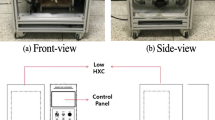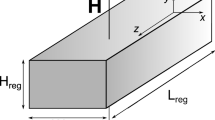Abstract
Magnetic refrigeration is based on the magnetocaloric effect, which refers to the ability of some materials to heat up when magnetized and cool down when demagnetized. An active magnetic regenerative (AMR) refrigeration apparatus using twin beds and a permanent magnet array was constructed for an experimental study. The twin AMR beds were filled with gadolinium spheres. They were magnetized and demagnetized in turn using a permanent magnet array and exchanged heat by means of water flowing back and forth between the hot and cold sides. The temperatures of various locations within the AMR beds were measured in real time. Herein, the experimental results using the apparatus are discussed.
Similar content being viewed by others
References
J. S. Lee, Principle of magnetic refrigeration and recent developments, Proc. of the SAREK 2000 Summer Annual Conference, Pyeongchang, Korea (2000) 1092–1097.
J. S. Lee and J. H. Hong, Experimental study on a rotary magnetic refrigeration device, Korean Journal of Air-Conditioning and Refrigeration Engineering, 16 (12) (2004) 1101–1106.
E. Warburg, Magnetische untersuchungen, Ann. Phys., 13 (1881) 141–164.
P. Debye, Einige bermerkungen zur magnetisierung bei tiefer temperatur, Ann. Phys., 81 (1926) 1154–1160.
W. F. Giauque, A thermodynamic treatment of certain magnetic effects. A proposed method of producing temperatures considerably below 1° absolute, J. Amer. Chem. Soc., 49 (1927) 1864–1870.
W. F. Giauque and D. P. MacDougall, Attainment of temperatures below 1° absolute by demagnetization of Gd2(SO4)·8H2O, Phys. Rev., 43 (1933) 768.
S. K. Jeong, Magnetic refrigeration, Air-Conditioning and Refrigeration Engineering, 24 (3) (1995) 271–282.
G. V. Brown, Magnetic heat pumping near room temperature, J. Appl. Phys., 47 (1976) 3673–3680.
W. A. Steyert, Stirling-cycle rotating magnetic refrigerators and heat engines for use near room temperature, J. Appl. Phys., 49 (3) (1978) 1216–1226.
J. A. Barclay and W. A. Steyert, Active magnetic regenerator, US Patent No. 4,332,135, June 1 (1982).
J. S. Lee, Recent R&D trend in magnetic refrigeration at room temperature, Proc. of the SAREK 2006 Summer Annual Conference, Pyungchang, Korea (2006) 613–618.
K. A. Gschneidner Jr. and V. K. Pecharsky, Thirty years of near room temperature magnetic cooling: Where we are today and future prospects, Int. J. Ref., 31 (6) (2008) 945–961.
B. Yu, M. Liu, P. W. Egolf and A. Kitanovski, A review of magnetic refrigerator and heat pumps built before the year 2010, Int. J. Ref., 33 (2010) 1029–1060.
J. R. Gomez, R. F. Garcia, J. C. Carril and M. R. Gomez, A review of room temperature linear reciprocating magnetic refrigerators, Renewable and Sustainable Energy Reviews, 21 (2013) 1–12.
K. Engelbrecht, D. Eriksen, C. R. H. Bahl, R. Bjork, J. Geyti, J. A. Lozano, K. K. Nielsen, F. Saxild, A. Smith and N. Pryds, Experimental results for a novel rotary active magnetic refrigerator, Int. J. Ref., 35 (2012) 1498–1505.
Y. Kim and S. Jeong, Experimental investigation on the room temperature active magnetic refrigerator with permanent magnet array, Proc. of the SAREK 2008 Winter Annual Conference, Seoul, Korea (2008) 186–191.
Y. Kim and S. Jeong, Investigation on performance of active magnetic regenerator considering entropy generation, Proc. of the SAREK 2010 Summer Annual Conference, Pyungchang, Korea (2010) 844–849.
I. Park, Y. Kim and S. Jeong, Development of the active magnetic regenerative refrigerator for room temperature application, Progress in Superconductivity and Cryogenics, 14 (3) (2012) 60–64.
Author information
Authors and Affiliations
Corresponding author
Additional information
Recommended by Associate Editor Jae Dong Chung
Jong Suk Lee is a professor in the Department of Precision Mechanical Engineering of Gangneung-Wonju National University. He graduated from Seoul National University majoring Mechanical Engineering in 1982. He received a master’s degree in 1987 and a Ph.D. degree in 1993 from Graduate College at Iowa State University. Currently he is involved in research on room-temperature magnetic refrigeration.
Rights and permissions
About this article
Cite this article
Lee, J.S. Experimental results for active magnetic regenerative refrigeration apparatus using twin beds. J Mech Sci Technol 29, 2237–2241 (2015). https://doi.org/10.1007/s12206-015-0444-z
Received:
Revised:
Accepted:
Published:
Issue Date:
DOI: https://doi.org/10.1007/s12206-015-0444-z




